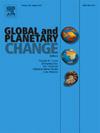中国黄土高原全新世尘积率的OSL年代叠加记录及其对北半球尘埃活动的影响
IF 4
1区 地球科学
Q1 GEOGRAPHY, PHYSICAL
引用次数: 0
摘要
准确重建地质尘埃活动对于了解过去的气候变化及其与尘埃循环的相互作用至关重要。中国黄土高原(CLP)上的黄土是重现过去尘埃活动的理想而敏感的材料。在此之前,中国黄土高原已广泛确定了不同时间尺度上沙尘质量累积率(MAR)的变化。然而,目前还很少有绝对年代的全新世沙尘记录。为了弥补这一空白,本研究汇编了 23 个中英文对照的全新世黄土剖面的光激发发光日期。我们通过贝叶斯年龄-深度模型建立了高质量的年代学,并为每个断面得出了一个MAR记录。然后,我们通过堆叠单个记录,获得了中国大陆坡的平均 MAR 记录。我们提出,与特定地点的MAR不同,叠加的MAR代表了整个中国大陆坡的平均尘积条件,可用于追踪相对大规模的尘积活动和气候变化。叠加的MAR记录表明,在距今11,5∼7,5,000年(ka BP)期间,沙尘堆积呈中度减弱趋势,随后在距今7,5∼3,000年(ka BP)期间,沙尘堆积呈明显增强趋势。与其他地区的沙尘记录相比,中国北部和蒙古西部的沙尘活动在公元前 8-6 千年发生了变化。我们认为,东亚冬季季风和夏季季风分别通过改变沙尘输送风能和沙尘源的干旱程度,共同促成了中国大陆坡全新世平均沙尘MAR的变化。将亚洲的全新世沙尘记录与西北太平洋和格陵兰岛的记录进行比较后发现,源自亚洲的近端和远端沙尘沉积之间的沙尘活动变化是不同步的。这是因为,与近端沉积不同,远端沉积不仅受尘源条件的控制,还受西风强度和位置的控制。本文章由计算机程序翻译,如有差异,请以英文原文为准。
An OSL-dated, stacked Holocene dust mass accumulation rate record on the Chinese Loess Plateau and its implications for Northern Hemisphere dust activity
Accurate reconstruction of geological dust activity is crucial for understanding past climate change and its interaction with dust cycle. Loess on the Chinese Loess Plateau (CLP) is an ideal and sensitive material for revisiting past dust activity. Previously, the changes in the dust mass accumulation rate (MAR) over various time scales were widely established on the CLP. However, few absolutely dated dust records have been obtained and synthesized for the Holocene. This study addresses this gap by compiling 23 optically stimulated luminescence-dated Holocene loess sections across the CLP. We developed a high-quality chronology via Bayesian age-depth modeling and derived a MAR record for each section. Then, we obtained a mean MAR record for the CLP by stacking individual records. We propose that, in contrast to site-specific MARs, stacked MARs represent the mean dust accumulation conditions for the entire CLP and can be used to track relatively large-scale dust activity and climate change. The stacked MAR record suggests a moderate weakening trend of dust accumulation from ∼11.5 to 7.5 thousand years ago (ka BP), followed by a pronounced strengthening trend from ∼7.5 to 3.0 ka BP. A comparison with other regional dust records reveals a shift in dust activity at ∼8–6 ka BP in northern China and western Mongolia. We argue that the East Asian winter and summer monsoons jointly contributed to Holocene mean dust MAR variations on the CLP by changing dust transport wind energy and dust source aridity, respectively. A comparison of Holocene dust records in Asia with those in the northwestern Pacific Ocean and Greenland suggests asynchronous variations in dust activity between proximal and distal Asia-sourced dust deposition. This is because, unlike proximal deposition, distal deposition can be controlled not only by the dust source conditions but also by the intensity and the position of the Westerlies.
求助全文
通过发布文献求助,成功后即可免费获取论文全文。
去求助
来源期刊

Global and Planetary Change
地学天文-地球科学综合
CiteScore
7.40
自引率
10.30%
发文量
226
审稿时长
63 days
期刊介绍:
The objective of the journal Global and Planetary Change is to provide a multi-disciplinary overview of the processes taking place in the Earth System and involved in planetary change over time. The journal focuses on records of the past and current state of the earth system, and future scenarios , and their link to global environmental change. Regional or process-oriented studies are welcome if they discuss global implications. Topics include, but are not limited to, changes in the dynamics and composition of the atmosphere, oceans and cryosphere, as well as climate change, sea level variation, observations/modelling of Earth processes from deep to (near-)surface and their coupling, global ecology, biogeography and the resilience/thresholds in ecosystems.
Key criteria for the consideration of manuscripts are (a) the relevance for the global scientific community and/or (b) the wider implications for global scale problems, preferably combined with (c) having a significance beyond a single discipline. A clear focus on key processes associated with planetary scale change is strongly encouraged.
Manuscripts can be submitted as either research contributions or as a review article. Every effort should be made towards the presentation of research outcomes in an understandable way for a broad readership.
 求助内容:
求助内容: 应助结果提醒方式:
应助结果提醒方式:


